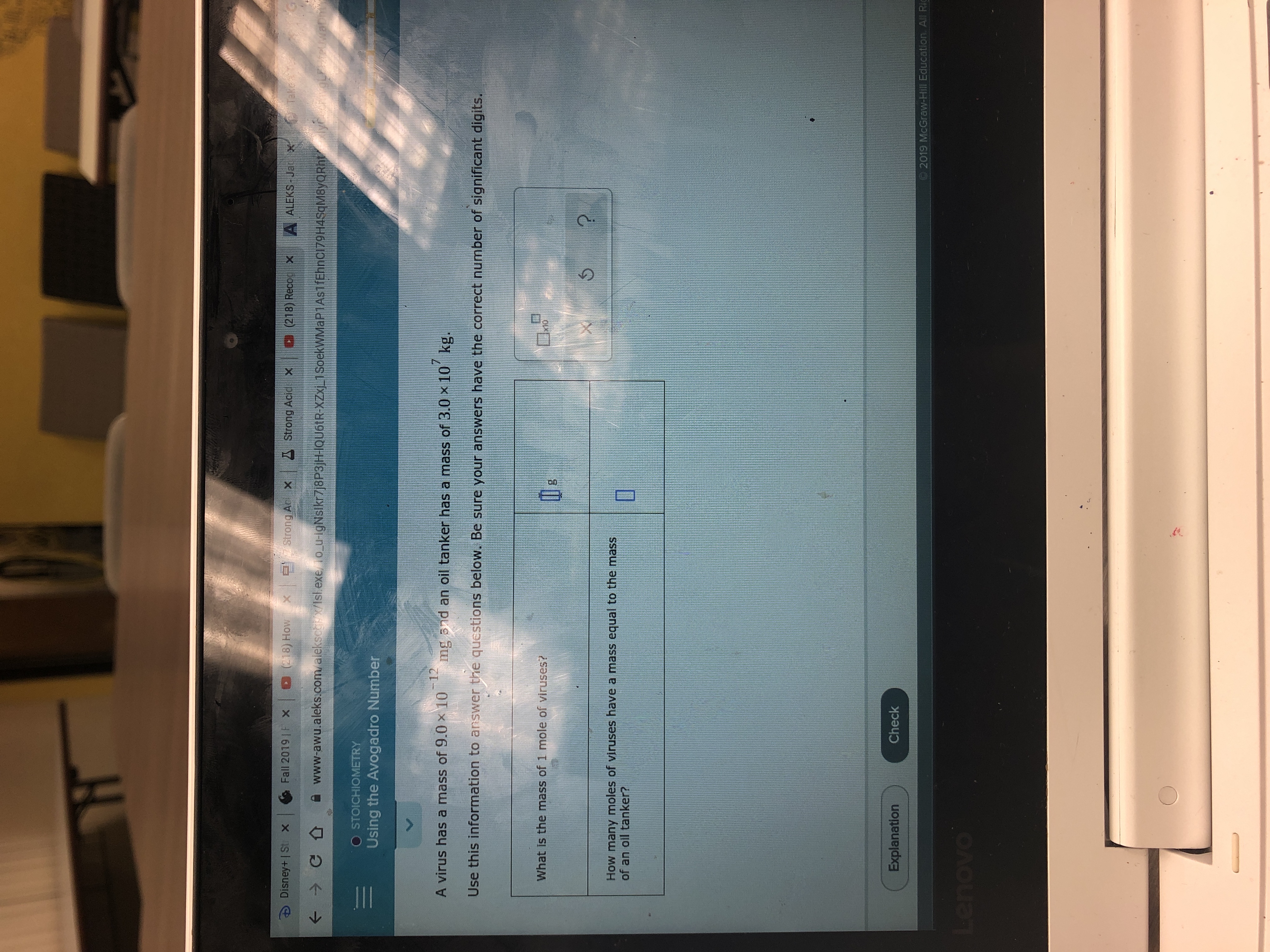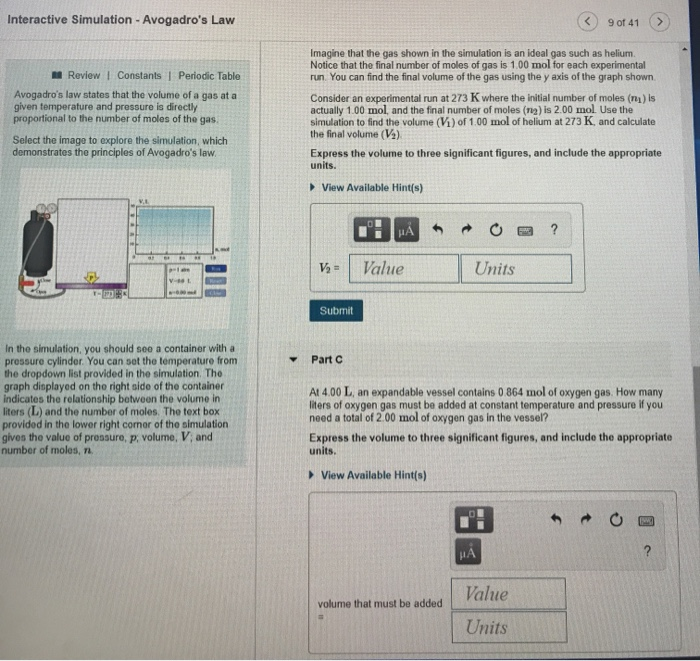Avogadro's Law states that two gases at the same temperature and volume will have an equal number of molecules, and therefore the same number of moles. It does not matter that helium has one atom per molecule while carbon tetrachloride has five atoms per molecule. Note that the given volume per mole of gas at STP is standard, and true for any gas. Avogadro's Law is the relation which states that at the same temperature and pressure, equal volumes of all gases contain the same number of molecules.The law was described by Italian chemist and physicist Amedeo Avogadro in 1811.

5.00 L of a gas is known to contain 0.965 mol. If the amount of gas is increased to 1.80 mol, what. Solving applications of Boyle's Law Using Charles's Law Using the combined gas law Using Avogadro's Law Using the ideal equation of state Interconverting molar mass and density of ideal gases Calculating partial pressure of a gas from a sketch Calculating partial pressure in a gas mixture.
Avogadro's law (sometimes referred to as Avogadro's hypothesis or Avogadro's principle) or Avogadro-Ampère's hypothesis is an experimental gas law relating the volume of a gas to the amount of substance of gas present.[1] The law is a specific case of the ideal gas law. A modern statement is:
Avogadro's law states that 'equal volumes of all gases, at the same temperature and pressure, have the same number of molecules.'[1]
For a given mass of an ideal gas, the volume and amount (moles) of the gas are directly proportional if the temperature and pressure are constant.
The law is named after Amedeo Avogadro who, in 1812,[2][3] hypothesized that two given samples of an ideal gas, of the same volume and at the same temperature and pressure, contain the same number of molecules. As an example, equal volumes of gaseous hydrogen and nitrogen contain the same number of atoms when they are at the same temperature and pressure, and observe ideal gas behavior. In practice, real gases show small deviations from the ideal behavior and the law holds only approximately, but is still a useful approximation for scientists.
Mathematical definition[edit]
The law can be written as:
or
where
- V is the volume of the gas;
- n is the amount of substance of the gas (measured in moles);
- k is a constant for a given temperature and pressure.
This law describes how, under the same condition of temperature and pressure, equal volumes of all gases contain the same number of molecules. For comparing the same substance under two different sets of conditions, the law can be usefully expressed as follows:
The equation shows that, as the number of moles of gas increases, the volume of the gas also increases in proportion. Similarly, if the number of moles of gas is decreased, then the volume also decreases. Thus, the number of molecules or atoms in a specific volume of ideal gas is independent of their size or the molar mass of the gas.
Derivation from the ideal gas law[edit]
The derivation of Avogadro's law follows directly from the ideal gas law, i.e.
- ,
where R is the gas constant, T is the Kelvin temperature, and P is the pressure (in pascals).
Solving for V/n, we thus obtain
- .
Compare that to
which is a constant for a fixed pressure and a fixed temperature.
An equivalent formulation of the ideal gas law can be written using Boltzmann constantkB, as
- ,
where N is the number of particles in the gas, and the ratio of R over kB is equal to the Avogadro constant.

In this form, for V/N is a constant, we have
- .
If T and P are taken at standard conditions for temperature and pressure (STP), then k′ = 1/n0, where n0 is the Loschmidt constant.
Historical account and influence[edit]
Avogadro's hypothesis (as it was known originally) was formulated in the same spirit of earlier empirical gas laws like Boyle's law (1662), Charles's law (1787) and Gay-Lussac's law (1808). The hypothesis was first published by Amadeo Avogadro in 1811,[4] and it reconciled Dalton atomic theory with the 'incompatible' idea of Joseph Louis Gay-Lussac that some gases were composite of different fundamental substances (molecules) in integer proportions.[5] In 1814, independently from Avogadro, André-Marie Ampère published the same law with similar conclusions.[6] As Ampère was more well known in France, the hypothesis was usually referred there as Ampère's hypothesis,[note 1] and later also as Avogadro–Ampère hypothesis[note 2] or even Ampère–Avogadro hypothesis.[7]
Experimental studies carried out by Charles Frédéric Gerhardt and Auguste Laurent on organic chemistry demonstrated that Avogadro's law explained why the same quantities of molecules in a gas have the same volume. Nevertheless, related experiments with some inorganic substances showed seeming exceptions to the law. This apparent contradiction was finally resolved by Stanislao Cannizzaro, as announced at Karlsruhe Congress in 1860, four years after Avogadro's death. He explained that these exceptions were due to molecular dissociations at certain temperatures, and that Avogadro's law determined not only molecular masses, but atomic masses as well.
Ideal gas law[edit]
Boyle, Charles and Gay-Lussac laws, together with Avogadro's law, were combined by Émile Clapeyron in 1834,[8] giving rise to the ideal gas law. At the end of the 19th century, later developments from scientists like August Krönig, Rudolf Clausius, James Clerk Maxwell and Ludwig Boltzmann, gave rise to the kinetic theory of gases, a microscopic theory from which the ideal gas law can be derived as an statistical result from the movement of atoms/molecules in a gas.
Avogadro constant[edit]
Avogadro's law provides a way to calculate the quantity of gas in a receptacle. Thanks to this discovery, Johann Josef Loschmidt, in 1865, was able for the first time to estimate the size of a molecule.[9] His calculation gave rise to the concept of the Loschmidt constant, a ratio between macroscopic and atomic quantities. In 1910, Millikan'soil drop experiment determined the charge of the electron; using it with the Faraday constant (derived by Michael Faraday in 1834), one is able to determine the number of particles in a mole of substance. Wwe smackdown vs raw 2009. At the same time, precision experiments by Jean Baptiste Perrin led to the definition of Avogadro's number as the number of molecules in one gram-molecule of oxygen. Perrin named the number to honor Avogadro for his discovery of the namesake law. Later standardization of the International System of Units led to the modern definition of the Avogadro constant.
Molar volume[edit]
Taking STP to be 101.325 kPa and 273.15 K, we can find the volume of one mole of gas:
For 101.325 kPa and 273.15 K, the molar volume of an ideal gas is 22.4127 dm3⋅mol−1.
See also[edit]
- Boyle's law – Relationship between pressure and volume in a gas at constant temperature
- Charles's law – Relationship between volume and temperature of a gas at constant pressure
- Gay-Lussac's law – Relationship between pressure and temperature of a gas at constant volume.
- Ideal gas – Mathematical model which approximates the behavior of real gases
Notes[edit]
- ^First used by Jean-Baptiste Dumas in 1826.
- ^First used by Stanislao Cannizzaro in 1858.

References[edit]
- ^ abEditors of the Encyclopædia Britannica. 'Avogadro's law'. Encyclopædia Britannica. Retrieved 3 February 2016.CS1 maint: extra text: authors list (link)
- ^Avogadro, Amedeo (1810). 'Essai d'une manière de déterminer les masses relatives des molécules élémentaires des corps, et les proportions selon lesquelles elles entrent dans ces combinaisons'. Journal de Physique. 73: 58–76.English translation
- ^'Avogadro's law'. Merriam-Webster Medical Dictionary. Retrieved 3 February 2016.
- ^Avogadro, Amadeo (July 1811). 'Essai d'une maniere de determiner les masses relatives des molecules elementaires des corps, et les proportions selon lesquelles elles entrent dans ces combinaisons'. Journal de Physique, de Chimie, et d'Histoire Naturelle (in French). 73: 58–76.
- ^Rovnyak, David. 'Avogadro's Hypothesis'. Science World Wolfram. Retrieved 3 February 2016.
- ^Ampère, André-Marie (1814). 'Lettre de M. Ampère à M. le comte Berthollet sur la détermination des proportions dans lesquelles les corps se combinent d'après le nombre et la disposition respective des molécules dont les parties intégrantes sont composées'. Annales de Chimie (in French). 90 (1): 43–86.
- ^Scheidecker-Chevallier, Myriam (1997). 'L'hypothèse d'Avogadro (1811) et d'Ampère (1814): la distinction atome/molécule et la théorie de la combinaison chimique'. Revue d'Histoire des Sciences (in French). 50 (1/2): 159–194. doi:10.3406/rhs.1997.1277. JSTOR23633274.
- ^Clapeyron, Émile (1834). 'Mémoire sur la puissance motrice de la chaleur'. Journal de l'École Polytechnique (in French). XIV: 153–190.
- ^Loschmidt, J. (1865). 'Zur Grösse der Luftmoleküle'. Sitzungsberichte der Kaiserlichen Akademie der Wissenschaften Wien. 52 (2): 395–413.English translation.
A flat tire is not very useful. It does not cushion the rim of the wheel and creates a very uncomfortable ride. When air is added to the tire, the pressure increases as more molecules of gas are forced into the rigid tire. How much air should be put into a tire depends on the pressure rating for that tire. Too little pressure and the tire will not hold its shape. Too much pressure and the tire could burst.

Avogadro's Law
You have learned about Avogadro's hypothesis: equal volumes of any gas at the same temperature and pressure contain the same number of molecules. It follows that the volume of a gas is directly proportional to the number of moles of gas present in the sample. Avogadro's Law states that the volume of a gas is directly proportional to the number of moles (or number of particles) of gas when the temperature and pressure are held constant. The mathematical expression of Avogadro's Law is:
[V = k times n]
or
[dfrac{V_1}{n_1} = dfrac{V_2}{n_2}]
where (n) is the number of moles of gas and (k) is a constant. Avogadro's Law is in evidence whenever you blow up a balloon. The volume of the balloon increases as you add moles of gas to the balloon by blowing it up.
If the container holding the gas is rigid rather than flexible, pressure can be substituted for volume in Avogadro's Law. Adding gas to a rigid container makes the pressure increase.
Example (PageIndex{1})
A balloon has been filled to a volume of (1.90 : text{L}) with (0.0920 : text{mol}) of helium gas. If (0.0210 : text{mol}) of additional helium is added to the balloon while the temperature and pressure are held constant, what is the new volume of the balloon?
Solution
Steps for Problem Solving | |
|---|---|
| Identify the 'given' information and what the problem is asking you to 'find.' | Given: (V_1 = 1.90 : text{L}) (n_1 = 0.0920 : text{mol}) Find: (V_2 = ? : text{L}) Kahiin to hoga all episodesselfiequiet. |
| List other known quantities. | Note that the final number of moles has to be calculated by adding the original number of moles to the moles of added helium. (n_2 = 0.0920 + 0.0210 = 0.1130 : text{mol}) |
Plan the problem. | First, rearrange the equation algebraically to solve for (V_2). [V_2 = frac{V_1 times n_2}{n_1}] |
Calculate. | Now substitute the known quantities into the equation and solve. [V_2 = frac{1.90 : text{L} times 0.1130 : cancel{text{mol}}}{0.0920 : cancel{text{mol}}} = 2.33 : text{L}] |
| Think about your result. | Since a relatively small amount of additional helium was added to the balloon, its volume increases slightly. |
Exercise (PageIndex{1})

A 12.8 L volume of gas contains .000498 moles of oxygen gas. At constant temperature and pressure, what volume does .0000136 moles of the gas fill?
Avogadro's Law Problems
0.350 L
Avogadro's Law Formula
Summary
- Calculations for relationships between volume and number of moles of a gas can be performed using Avogadro's Law.
Contributions & Attributions
This page was constructed from content via the following contributor(s) and edited (topically or extensively) by the LibreTexts development team to meet platform style, presentation, and quality: Holiday stressdialectical behavioral training.
CK-12 Foundation by Sharon Bewick, Richard Parsons, Therese Forsythe, Shonna Robinson, and Jean Dupon.
Marisa Alviar-Agnew (Sacramento City College)
Henry Agnew (UC Davis)
